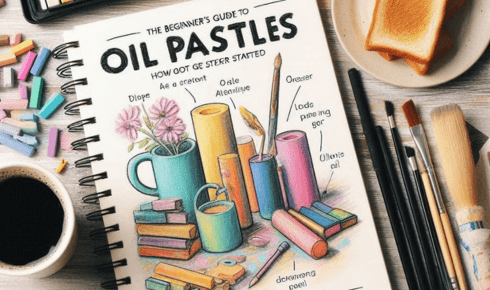The Beginner’s Guide to Oil Pastels: How to Get Started

Oil pastels are a versatile and vibrant medium that can bring your artistic visions to life with bold colors and unique textures. Whether you’re a beginner looking to explore a new creative outlet or an experienced artist curious about experimenting with a different medium, oil pastels offer a fun and rewarding experience. But where do you start? Here’s a beginner’s guide to help you get started with oil pastels and make the most of their potential.
What Are Oil Pastels?
Oil pastels are a type of crayon made from a blend of pigment, non-drying oil, and wax. Unlike soft pastels, which are powdery and delicate, oil pastels have a creamy, buttery consistency that allows for vibrant color application and smooth blending. They are also more durable and less prone to smudging, making them ideal for beginners who want to experiment without worrying about excessive mess.
Choosing Your First Set of Oil Pastels
As a beginner, it’s tempting to go for the cheapest set available, but investing in a mid-range or student-grade set can make a significant difference in your learning experience. Beginner oil pastels should offer vibrant colors, good blending capabilities, and a smooth texture. Brands like Pentel, Sakura, and Faber-Castell provide excellent starter sets that balance quality and affordability.
Essential Tools and Materials
To get started with oil pastels, you’ll need a few basic supplies:
- Oil Pastels: Choose a set with at least 12 colors to give yourself enough variety to experiment.
- Paper: Go for heavyweight paper, preferably designed for pastels or mixed media, as it can handle the layering and blending of oil pastels without tearing.
- Blending Tools: Your fingers work great for blending, but you can also use cotton swabs, paper stumps, or even a soft cloth.
- Fixative Spray: To protect your finished artwork from smudging, consider using a spray fixative specifically made for oil pastels.
How to Use Oil Pastels
One of the best things about oil pastels is their versatility. Here are some fundamental techniques to help you get started:
1. Layering and Blending:
Start by applying a light layer of color and gradually build up layers to create depth and richness. Oil pastels don’t dry out, so you can keep blending and working on your piece until you’re satisfied. For smooth transitions between colors, use your fingers or blending tools to gently mix the pigments.
2. Sgraffito Technique:
This involves scratching through the top layer of pastel to reveal the color underneath. To do this, layer a light color first and then cover it with a darker shade. Use a palette knife or toothpick to scrape away parts of the top layer, creating interesting textures and patterns.
3. Impasto Effect:
You can apply oil pastels thickly to achieve a textured, three-dimensional look. This technique mimics the style of oil painting and is great for adding highlights or creating bold, expressive strokes.
4. Mixing with Solvents:
For a more painterly effect, blend oil pastels with a small amount of mineral spirits or turpentine using a brush. This technique helps soften edges and creates a smooth, almost watercolor-like finish.
Tips for Beginners
- Start Simple: Begin with basic shapes and color blocking. Don’t worry about perfect details at first; focus on learning how the colors blend and layer.
- Experiment with Pressure: Apply light pressure for a softer, translucent look, and press harder for bold, opaque colors.
- Clean Your Pastels: Wipe the tip of your pastel with a tissue before switching colors to avoid muddying your artwork.
- Work from Light to Dark: Since oil pastels are opaque, it’s easier to layer darker colors on top of lighter ones than the other way around.
- Protect Your Work: Use a fixative spray to prevent smudging, especially if you plan to store or display your artwork.
Common Mistakes to Avoid
- Overblending: It’s easy to get carried away with blending, but overdoing it can result in muddy colors. Know when to stop for a more vibrant and dynamic piece.
- Choosing the Wrong Paper: Thin or smooth paper doesn’t hold oil pastels well. Opt for textured, heavyweight paper designed for pastels or mixed media.
- Skipping the Fixative: Oil pastels never fully dry, so always seal your work to avoid accidental smudges and fingerprints.
Why Use Oil Pastels?
Oil pastels are perfect for beginners because they are easy to use, require minimal setup, and encourage experimentation. They allow you to explore color theory, layering techniques, and texture creation without the need for brushes, water, or extensive drying time. Plus, they are highly portable, making them great for sketching outdoors or while traveling.
Starting with oil pastels can be an exciting and rewarding journey. By investing in the right tools, practicing fundamental techniques, and allowing yourself to explore creatively, you’ll discover just how versatile and enjoyable this medium can be. Remember, the key to mastering oil pastels is practice and experimentation. So grab your set, choose your canvas, and start creating vibrant, expressive art today! Often, for wall art print, for personalized gifts, too, the artist uses acrylic or other paints.

